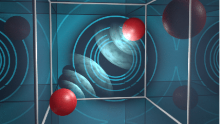DOE-SC highlight: Understanding charged-particle bound states in periodic boxes

Share this article:
Share this article:
The U.S. Department of Energy Office of Science (DOE-SC) posted a highlight titled “Understanding charged-particle bound states in periodic boxes.” The highlight explains how researchers solved a long-standing and fundamental problem regarding charged systems in a finite-volume with periodic boundary conditions. In an atomic nucleus, the "strong nuclear force" binds protons and neutrons together. However, accurate descriptions of a nucleus must also consider the electromagnetic repulsion between protons. This force is particularly strong at the lowest energies, where many important processes take place that create the elements that make up the world.
This work was performed by a collaboration of scientists from North Carolina State University and FRIB. This study means that nuclear binding energies can now be more accurately predicted from lattice simulations that use finite-volume boxes and must be extrapolated to infinite box size. Among other implications, the study allows researchers to extract parameters that play an important role in low-energy astrophysical reactions where one nucleus is captured by another to produce a new element.
Each year, scientists publish thousands of research findings in the scientific literature. About 200 of these are selected annually by their respective program areas in DOE-SC as publication highlights of special note.

